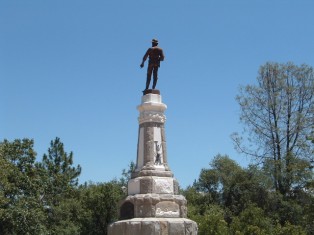Eureka, the American Gold Rush
Captain John Augustus Sutter (1803-1880) was a German Swiss who had been a shopkeeper in his native country. In 1834, beleaguered by debt and an unhappy marriage, he took off for five years of travel, looking to start fresh in a new locale. He visited New York and Honolulu and finally arrived in California in July 1839. There, the Mexican government awarded him a land grant of about 50,000 acres. At his colony of New Helvetia, he built Sutter’s Fort on the present site of Sacramento. When the Russians left Fort Ross, Sutter bought all their supplies and livestock. Sutter’s fort then became the principal supplier for the trappers, farmers, and ranchers of the whole are. He employed gunsmiths and amassed 12,000 cattle, 2,000 horses and mules, 10,000 sheep, and 1,000 hogs. Business was so good that he had over 1,000 people on his payroll. If you had told him he was sitting on a proverbial gold mine, he would have agreed with you. In September 1847, Sutter sent James Marshall with a work crew of 10 Americans and 10 Cullumah Indians to start construction on a mill. By December, it was almost ready for operation, but for a small problem. The river had been dammed to divert part of the stream into a channel, called a millrace, that would carry water through the mill. Below that, another diversion of the river, called the tailrace, carried water away from the mill and back into the American River. The tailrace was not deep enough, so the water was backing up, and the big mill wheel wouldn’t turn. To solve the problem, the builders decided to deepen the tailrace channel down to the bedrock. Every day, they removed more boulders and dirt; every night, water ran through the channel, washing away more of the loose debris. James Marshall had been a New Jersey carriage-maker. In 1844, he had headed west, traveling the Oregon Trail to Puget Sound. By the time of the Bear Flag Revolt he was already working for John Sutter. But his true mark on history would be made on January 24, 1848. On that morning, while working to clear the tailrace of Sutter’s new sawmill, something shining in the mud caught his eye. “Boys,” the 36-year-old carpenter said to his crew, “by God I believe I found a gold mine. He then showed them the flakes. The men laughed it off. Later that night at chow, Marshall again showed his find to his co-workers, and then tossed the nuggets into a boiling pot. They didn’t melt or reshape. Marshall went out again the next morning and found a few more samples. He’d done a little reading in the night and was beginning to think it was a bonehead thing to have told his cohorts about his discovery. With even more glistening pebbles, he left on January 28 to tell his boss at Sutter’s Fort, about fifty miles away. See where James Marshall stated it all at the Marshall Gold Discovery State Historic Park off Highway 49 in Coloma, California. It features period exhibits of mining equipment, horse-drawn vehicles, household implements, and other memorabilia, as well as films on the gold discovery and early mining techniques. Some of the nicest people in the world work at the part too. You’ll learn a lot and have a ball doing it. If you’d like to know more about James Marshall and Captain John Sutter, email me at www.chrisenss.com and I’ll send you a copy of the book Tales Behind the Tombstones.


